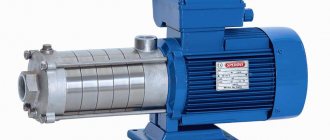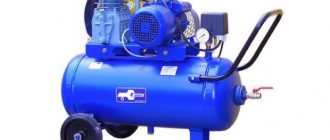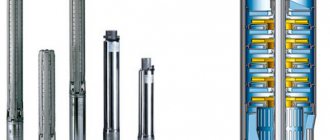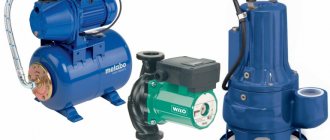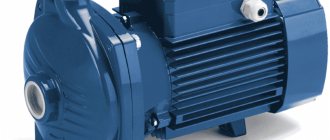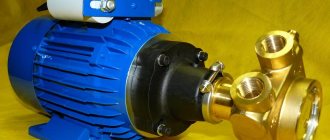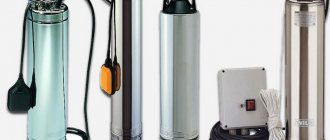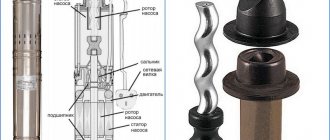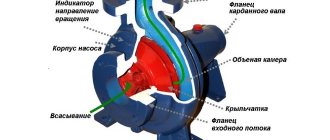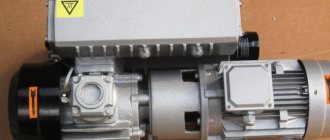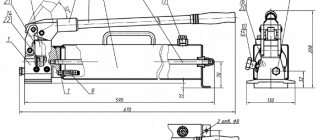A screw pump is a unit designed for pumping solutions and liquids of high viscosity. This kind of equipment is used in many areas of industry - textile chemical and metalworking production. Screw pumps have a simple design, are reliable and have a long service life.
Screw pump design - what does the device consist of?
The main element of a screw pump is the rotor. It has a cylindrical shape and a spiral groove resembling a screw or auger. The rotor is located inside a stator equipped with an elastomeric sleeve and a spiral channel. The stator itself has the shape of a steel pipe. The rotary spiral can be equipped with several passes. In this case, the stator spiral is always equipped with one more entry.
Along the contact line between the stator and the rotor there are areas protected from water penetration, dividing the working cavity of the pump into several parts. Due to the special arrangement of the rotor in the stator, these sections alternately open and close.
The volume of pumped liquid is adjusted by changing the number of rotor revolutions. To do this, use a frequency drive.
All pump elements are housed in a durable plastic or cast iron housing. Moreover, if a screw pump is used for a well, its body is made of stainless steel.
Operating principle and purpose of the device
The operating principle of each screw unit is based on the movement of liquid along the screw axis inside the chamber. The axis is formed between the surface of the housing and the helical grooves by inserting the helical projections into adjacent grooves. Thanks to this operating principle, a closed space is created inside the device, which does not allow liquid to move back out of the device.
Nowadays, screw pumps are used in many areas of human activity. Most often this equipment is used:
- In food factories - in food production, units are used as dispensers;
- In construction - pumps are used to supply mixtures used for the production of self-leveling floors and roofing;
- At wells, devices pump out contaminated water with a large amount of impurities. A screw well pump can be used both for a source with clean water and for a well with sand;
- In the chemical industry, screw pumps pump large volumes of thick substances for further processing.
High reliability and the ability to operate under high loads make screw pumps one of the most progressive types of pumping equipment.
Advantages and disadvantages of screw pumps
The high demand for screw pumps is due to their many advantages. Among them it is necessary to highlight:
- High efficiency of devices – from 50 to 70%;
- The units are capable of working with very viscous liquid, creating a pressure much higher than impeller pumps;
- Screw pumps are capable of pumping liquids with large amounts of solid impurities;
- The operating principle of the screw device eliminates the formation of pulsations, which are typical for other types of equipment;
- Screw pumps are self-priming devices, and the maximum liquid intake depth can be 8.5 m;
- The devices are compact and have low noise levels;
- Due to their high reliability, screw pumps rarely require repairs and do not require frequent maintenance.
Like other types of pumps, screw equipment has its weaknesses. The first disadvantage is the high cost of the units, which is why not all enterprises can afford to use them in their production. The second drawback is the inability to adjust the volume of pumped liquid.
Installation Rules
In order for the submersible screw pump to last as long as possible, the following rules must be observed during installation:
- The water riser pipe must withstand the highest pressure in the system and match the dimensions of the outlet pipe.
- The flexible hose must prevent the formation of twists and kinks.
- Lifting and lowering of equipment should be carried out using nylon or steel cable. In any case, the pump must not be suspended by the electrical conductor.
- The diameter of the casing must allow the free passage of equipment, including cables and pipes.
- The pump should not be located less than 0.5 m from the bottom of the well.
- The unit should not pump water with the water shut-off valve closed.
- Pumping equipment must be equipped with a dry-running safety sensor.
- The electric cable should not be in a coil, as this will lead to overheating and melting of the insulation.
Advice! If the model is not equipped with a check valve from the factory, it must be installed during installation - on the outlet pipe in front of the water intake line.
Types of screw pumping equipment
Since screw devices are used in many fields of application, they differ from each other in their design features. According to their design, the units are divided into the following types:
- Screw pumps - these units are designed for pumping large volumes of aggressive chemicals and abrasives. The screw device works effectively in both vertical and horizontal positions. Often such equipment is used for water from wells and deep wells. Screw units have a simple design and relatively low cost;
- Rod pumps - these types of devices are used for highly viscous media in oil production and refining enterprises. The rod pump design includes a wellhead gland, a rotary column and a surface drive. Units of this type are characterized by high productivity and fairly high cost;
- Vacuum pumps - these units are equipped with two screw rotors rotating in opposite directions. Thanks to this design of the vacuum pump, the liquid first enters the area between the screw chambers and the cylinder, and then enters the exhaust port.
A screw pump for viscous liquids shows high performance, but the efficiency of the device largely depends on the correct use of it. In this regard, before purchasing a device for domestic or industrial purposes, you need to make sure that it is suitable for the chosen area of application.
Accessories
As mentioned earlier, for ease of operation, horizontal screw pumps can be supplied on mobile transport trolleys. The trolley pump option is used when there is a constant or periodic need to pump liquids in different parts of one workshop or the enterprise as a whole. The trolley can, as a place for installing additional equipment, approx. frequency converter.
For barrel screw pumps, by analogy with horizontal screw pumps, a bypass valve is installed. The bypass valve is connected directly to the pump discharge pipe. During operation of the pump, the pumped liquid acquires inertial force. When the valve in the supply line is closed and the pump motor is stopped, fluid continues to flow out of the pump, creating pressure. To avoid rupture of the pressure hose, a bypass valve is installed. It is mechanically adjusted to open at a certain pressure and allows liquid, which moves by inertia, to flow back into the container.
Since barrel screw pumps are designed to operate in mobile containers, they must be constantly installed from one container to another. Since the mass of these pumps is much greater than that of barrel centrifugal pumps, their reinstallation from container to container takes a lot of effort from the operating personnel. Therefore, the motors of barrel screw pumps are produced with an additional mounting bracket. It provides easy installation and dismantling of the pump using a hoist or crane beam. If the production facility where the barrel pump is used does not have lifting mechanisms, you can purchase a special trolley for barrels with a lifting device.
Which pump is better - a centrifugal pump or a screw pump?
Many people who want to buy a pump for household purposes think about what is better - a centrifugal or screw pump. Both of these types differ in their areas of use and design features.
A centrifugal pump is a fairly expensive device that can cope well with providing water to a country cottage. These pumps can be used for both wells and wells. The unit includes an impeller fixed on the shaft, which pushes water upward. This equipment is only suitable for pumping clean water, has high efficiency and consumes a small amount of electricity. Centrifugal pumps are characterized by high reliability and long service life.
Screw pumps are used primarily in industry. Much less often, a submersible unit of this kind is used in everyday life and on the farm. If just such a device was chosen for servicing a private home, then it should be used for pumping not too contaminated water, the amount of solid impurities in which should not exceed 150 g/m3 of liquid.
The choice of pumping equipment mainly depends on the water it will pump. If the unit is required to supply clean drinking water, then it is better to choose a centrifugal pump. If liquid is needed for irrigation, then it is better to give preference to screw equipment.
Principle of operation
The equipment maintains a constant flow - in contrast to the pulsating rhythm of the pumped medium in centrifugal versions of the equipment - this characteristic is important for working at great depths. Features of operation and structural components of self-priming volumetric pumps using the principle of a multi-stage structure:
- The design provides one vertical shaft, this helps reduce the transverse dimensions to a minimum. Because of the resulting configuration, pumps are used in wells and Abyssinian wells.
- As a container for the pumped liquid, a pump casing is used, made for use in well conditions from high-quality metal, since polymers cannot withstand the created loads.
- The movement of the liquid is ensured by the action of a screw screw (rotor), during the rotation of which the liquid is taken from the well, accelerated, pressure is given to it and then it moves through the hose.
- The rotor is powered by an electric motor and is driven through a rigid shaft. The stability of the installation is ensured with the help of a bearing set and other components that are selected by the designers depending on the class of the unit.
- The rotor is a steel screw (single-thread auger) of circular cross-section, which has a wide thread pitch. The stator is represented in the design with the same cross-section, but its thread pitch is twice as large. By rotating inside the stator, the rotor captures water from the suction pipe and directs it to the outlet passage.
- The quality of the pump depends on the complexity of the internal structure; the higher the indicator, the longer the service life is due to the minimization of wear on the drives and screw.
- In transmission pumps, unlike submersible ones, the motor is located on the surface, next to the water intake well, and is connected to the pumping device by an intermediate shaft. Such units are capable of lifting oil from depth to the surface from a depth of 125-130 m with a supply of 1200 m³ per hour.
- For transmission devices, the pump part consists of several cast iron sections connected by studs. Each chamber contains a working centrifugal wheel and a shaft, all sections fit into one mesh that allows water to pass through.
- Several working sections allow you to set the required pressure and regulate it, while the unit interacts with the pressure pipeline through a flange located on the upper body of the section. The transmission is located inside a protective pipe containing oil. The sections are assembled gradually, increasing their number as they enter the well.
Submersible pump designs feature a rigid connection between the motor and shaft, so there is no need to use a transmission shaft, which helps to simplify the design. Submersible units are successfully installed in crooked shafts, and the working building for equipment above the wellhead is smaller in volume. Submersible pumps have a longer service life compared to other options, since vibration is significantly reduced due to their reliable design.
Screw and vane pumps - what are the differences?
Most inexperienced buyers often make the mistake of mistaking a vane pump for a screw pump. The differences between these types of units lie in the areas of application and characteristics of the units.
Screw devices are mostly used for industrial purposes, much less often in everyday life. Among their advantages are:
- Uniform supply volume of the pumped liquid;
- Self-priming ability;
- Excellently balanced design;
- The unit operates efficiently even if there are solid impurities in the liquid;
- High strength of parts.
The disadvantages of screw pumps include the high cost of equipment, large dimensions, increased friction of its spare parts, high noise levels and ineffective cooling.
Vane pumps are used in everyday life. The centrifugal vane pump has the following advantages:
- Easy to operate and maintain;
- Possibility of connecting several vane pumps to one pipeline at once;
- Modest dimensions and weight;
- Low noise level during operation;
- Low cost of most models;
- Availability of an effective cooling system.
Among the disadvantages of a roller vane pump, the inability to work with contaminated water should be highlighted. The centrifugal vane pump has low efficiency, and when the flow channels are narrowed, most units overheat, which leads to their breakdown. For the production of most models, heavy steel parts are used, which, when paired with a light plastic body, impair the balance and stability of the devices.
An important characteristic of a vane pump is its performance. It greatly depends on the quality of the water and the power of the unit. If the pump does not have high power, then it will not pump the amount of liquid necessary to service a private home. Therefore, for suburban housing, you should choose more powerful equipment, the purchase of which will cost much more.
Tests
The main test criterion for all types of pumps is the volume of liquid pumped under a given pressure per unit of time. Taking into account the specifics of the design, when changing a given pressure value, it is possible to determine an incorrectly maintained gap between the rotor and the cage, or an incorrectly set angle of inclination of the teeth, or the number of revolutions per minute of the rotor.
Another important factor in testing this type of pump is its balance (absence of free vibrations during shaft rotation). Timely elimination of mass imbalance along the rotor axis can prolong its life and, accordingly, save money on its further maintenance.
When evaluating new equipment, a design analysis is carried out for profitability (payback). This means that the newly manufactured pump, with the same characteristics as the analogue throughput capacity of the pumped liquid (gas), must have a reduced power consumption (taking into account a number of possible assumptions with the angles of inclination of the shaft, this is quite acceptable, using, for example, a variable angle of inclination of the teeth along the shaft axis) , the material from which the pump is made is also important. Its price and mechanical characteristics (resistance to aggressive environments, thermal conductivity) play an important role in the cost of the equipment and its reliability.
